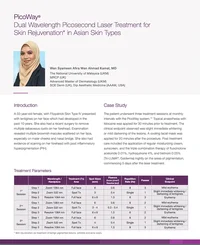PicoWay® Dual Wavelength Picosecond Laser Treatment for Skin Rejuvenation* in Asian Skin Types
Wan Syameen Afira Wan Ahmad Kamal, MD
The National University of Malaysia (UKM)
MRCP (UK)
Advanced Master of Dermatology (UKM)
SCE Derm (UK), Dip Aesthetic Medicine (AAAM, USA)
 Although Asian skin has a relatively higher melanin content with a better photoprotection, cases of solar lentigines are still commonly observed, hence raising some aesthetic concerns. As melanin has a broad absorption spectrum ranging from 351 to 1,064 nm, the treatment for melanin-containing lesions would be lasers of the same wavelengths.1 Notably, in spite of its efficacy, Q-switched laser treatments can cause PIH in up to 10-47% cases when treating lentigines, especially in those with darker skin types.2 The shorter pulse widths, in the picosecond laser domain, destroy melanosomes by way of photoacoustic effect. Electron microscopy demonstrated destroyed melanosomes with surrounding tissue damage with Q-switched Nd:YAG laser, whereas no obvious surrounding tissue damage was observed in picosecond laser treated skin samples, making it a safer alternative in darker skinned individuals.2
Although Asian skin has a relatively higher melanin content with a better photoprotection, cases of solar lentigines are still commonly observed, hence raising some aesthetic concerns. As melanin has a broad absorption spectrum ranging from 351 to 1,064 nm, the treatment for melanin-containing lesions would be lasers of the same wavelengths.1 Notably, in spite of its efficacy, Q-switched laser treatments can cause PIH in up to 10-47% cases when treating lentigines, especially in those with darker skin types.2 The shorter pulse widths, in the picosecond laser domain, destroy melanosomes by way of photoacoustic effect. Electron microscopy demonstrated destroyed melanosomes with surrounding tissue damage with Q-switched Nd:YAG laser, whereas no obvious surrounding tissue damage was observed in picosecond laser treated skin samples, making it a safer alternative in darker skinned individuals.2
Learn more about PicoWay laser device
**PicoWay Laser, FDA 510k clearance [K220853], Oct 2022. PicoWay Laser Health Canada Licence (94931), Amended 2023/2/13. PicoWay CE Mark. PicoWay Australian Register of Therapeutic Goods (ARTG) clearance (ARTG 88730).
1. Vachiramon V, Lamsumang W, Triyangkulsri K. Q-switched double frequency Nd:YAG 532-nm nanosecond laser vs. double frequency Nd:YAG 532-nm picosecond laser for the treatment of solar lentigines in Asians. Lasers Med Sci. 2018 Dec;33(9):1941-1947.
2. Negishi K, Akita H, Matsunaga Y. Prospective study of removing solar lentigines in Asians using a novel dual-wavelength and dual pulse width picosecond laser. Lasers Surg Med. 2018 Oct;50(8):851-858.
3. Kung KY, Shek SY, Yeung CK, Chan HH. Evaluation of the safety and efficacy of the dual wavelength picosecond laser for the treatment of benign pigmented lesions in Asians. Lasers Surg Med. 2019 Jan;51(1):14-22.
4. Wang CC. In vivo characterization of the threshold of laser-induced optical breakdown (LIOB) of a fractional 1064 nm Nd:YAG picosecond laser by optical coherence tomography: A step forward to precision laser therapy. J Cosmet Dermatol. 2022 Sep;21(9):3817-3820.
 Japan
Japan Korea
Korea China
China